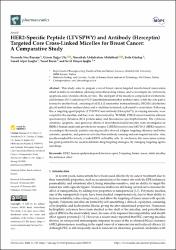| dc.contributor.author | Bayram, Nazende Nur | |
| dc.contributor.author | Ulu, Gizem Tuğçe | |
| dc.contributor.author | Abdulhadi, Nusaibah Abdulsalam | |
| dc.contributor.author | Gürdap, Seda | |
| dc.contributor.author | İşoğlu, İsmail Alper | |
| dc.contributor.author | Baran, Yusuf | |
| dc.contributor.author | İşoğlu, Sevil Dinçer | |
| dc.date.accessioned | 2024-02-23T11:48:21Z | |
| dc.date.available | 2024-02-23T11:48:21Z | |
| dc.date.issued | 2023 | en_US |
| dc.identifier.issn | 1999-4923 | |
| dc.identifier.other | WOS:000959599500001 | |
| dc.identifier.uri | https://doi.org/10.3390/pharmaceutics15030733 | |
| dc.identifier.uri | https://hdl.handle.net/20.500.12573/1960 | |
| dc.description.abstract | This study aims to prepare a novel breast cancer-targeted micelle-based nanocarrier,
which is stable in circulation, allowing intracellular drug release, and to investigate its cytotoxicity,
apoptosis, and cytostatic effects, in vitro. The shell part of the micelle is composed of zwitterionic
sulfobetaine ((N-3-sulfopropyl-N,N-dimethylamonium)ethyl methacrylate), while the core part is
formed by another block, consisting of AEMA (2-aminoethyl methacrylamide), DEGMA (di(ethylene
glycol) methyl ether methacrylate), and a vinyl-functionalized, acid-sensitive cross-linker. Following
this, a targeting agent (peptide (LTVSPWY) and antibody (Herceptin®)), in varying amounts, were
coupled to the micelles, and they were characterized by 1H NMR, FTIR (Fourier-transform infrared
spectroscopy), Zetasizer, BCA protein assay, and fluorescence spectrophotometer. The cytotoxic,
cytostatic, apoptotic, and genotoxic effects of doxorubicin-loaded micelles were investigated on
SKBR-3 (human epidermal growth factor receptor 2 (HER2)-positive) and MCF10-A (HER2-negative).
According to the results, peptide-carrying micelles showed a higher targeting efficiency and better
cytostatic, apoptotic, and genotoxic activities than antibody-carrying and non-targeted micelles. Also,
micelles masked the toxicity of naked DOX on healthy cells. In conclusion, this nanocarrier system
has great potential to be used in different drug-targeting strategies, by changing targeting agents
and drugs. | en_US |
| dc.language.iso | eng | en_US |
| dc.publisher | MDPI | en_US |
| dc.relation.isversionof | 10.3390/pharmaceutics15030733 | en_US |
| dc.rights | info:eu-repo/semantics/openAccess | en_US |
| dc.subject | HER2 | en_US |
| dc.subject | human epidermal growth factor receptor 2 targeting | en_US |
| dc.subject | breast cancer | en_US |
| dc.subject | stable micelles | en_US |
| dc.subject | the antitumor effect | en_US |
| dc.title | HER2-Specific Peptide (LTVSPWY) and Antibody (Herceptin) Targeted Core Cross-Linked Micelles for Breast Cancer: A Comparative Study | en_US |
| dc.type | article | en_US |
| dc.contributor.department | AGÜ, Yaşam ve Doğa Bilimleri Fakültesi, Biyomühendislik Bölümü | en_US |
| dc.contributor.authorID | 0000-0002-8697-1654 | en_US |
| dc.contributor.authorID | 0000-0001-6428-4207 | en_US |
| dc.contributor.authorID | 0000-0001-6582-4981 | en_US |
| dc.contributor.institutionauthor | Bayram, Nazende Nur | |
| dc.contributor.institutionauthor | Gürdap, Seda | |
| dc.contributor.institutionauthor | İşoğlu, İsmail Alper | |
| dc.contributor.institutionauthor | İşoğlu, Sevil Dinçer | |
| dc.identifier.volume | 15 | en_US |
| dc.identifier.issue | 3 | en_US |
| dc.identifier.startpage | 1 | en_US |
| dc.identifier.endpage | 26 | en_US |
| dc.relation.journal | PHARMACEUTICS | en_US |
| dc.relation.tubitak | 216S639 | |
| dc.relation.publicationcategory | Makale - Uluslararası Hakemli Dergi - Kurum Öğretim Elemanı | en_US |


















